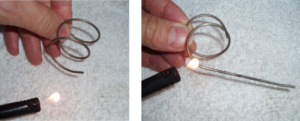Model Description
These figures demonstrate the two phases of a shape memory alloy which enables shape memory alloys to “memorize” their pre-deformed shape, even after large deformations. This demonstration should take 15 minutes.

Engineering Principle
The shape memory effect occurs due to a phase transition between the original, or memorized, austenite phase to a deformed martensite phase. Once a shape memory alloy is distorted into the deformed martensitic state, the material can “regain” its original austenitic shape if the material is heated to above its transition temperature. Nickel-titanium alloys, or Nitinol, allow up to 8 percent of recoverable deformation. When compared to steel, which only allows up to 0.8 percent of recoverable deformation, Nitinol has extremely large recoverable deformation which gives this material its truly remarkable properties. The transition temperature is approximately 150°F for the Nitinol used in the movie clips. This transition temperature can fluctuate from approximately -50°F to 300°F, depending upon the weight percent of each metal in the alloy.
What You Need
| Item | Quantity | Description/Clarification |
|---|---|---|
| Nitinol Sample | 1 | An 8 inch wire sample of Nitinol is used to perform the activities demonstrated in the movie clips above. It is important to know the exact transition temperature of the alloy since the demonstration depends on this. |
| Lighter | 1 | A standard household lighter to heat the deformed shape memory alloy above its transition temperature. |
| Clear Pan of Hot Water | 1 | A container (larger than the Nitinol sample) which can hold water heated to a temperature that is approximately 5-10 °F above the transition temperature. |
How It’s Done
Before Class: Heat the pan of water to a temperature of approximately 150°F using a Bunsen burner or any other heating source available. Ensure that the water temperature is adequate to induce the phase transformation between martensite and austenite. The water should be maintained at this steady state temperature until the time of the demonstration.
In Class: The different phases of a shape memory alloy, austenite and martensite, are discussed. In addition, the concept of the transition temperature is discussed and how the material can change from one phase to another based upon the transition temperature. We then show the students the sample of Nitinol and ask for a volunteer to deform the wire sample. The class is asked what phase the Nitinol sample is in after the volunteer has deformed the material. Then, with the heat resistant gloves on, the wire is heated with the lighter and the sample reverts back into its un-deformed, or austenite, shape. During the shape change, a discussion of phase changes is appropriate and the class is asked what phase the material is transitioning to with the application of heat from the lighter.
In a related experiment, the Nitinol is again deformed by a volunteer from the class. Ensuring that the pan of hot water is still at 150°F, the deformed Nitinol wire is dropped into the hot water. The Nitinol wire experiences a spontaneous transition where the wire “snaps back” into its undeformed, or austenitic, phase. Again, during the conduct of this related experiment, the same questions should be posed to the class (i.e. in what phase is the un-deformed wire, what phase is the Nitinol upon deformation, etc.).
Observations: The students should observe the shape memory alloy returning back to its memorized shape after experiencing extremely large deformations. This demonstrates the shape memory alloy transitioning from austenite to martensite and back again by means of a thermally induced-recoverable phase transformation. The shape memory alloy returns to its un-deformed state since the material is heated above its transition temperature. The heat serves as a source of energy to transform the lattice structure which leads to a phase change from martensite to austenite. This phase transformation can also be induced by stress – the so-called super-elastic effect.
The superelastic behavior of Nitinol is used in the design of stents. The transformation temperatures are set to be slightly below body temperature. The superelastic effect is caused by the stress-induced formation of some martensite above its normal temperature. Because martensite has been formed above its normal temperature, the martensite reverts immediately to un-deformed austenite when the stress is removed. This process provides the elasticity in these alloys for strains up to about 8%. A common application of the super-elasticity in Nitinol is seen in eye-glass frames which can experience large deformations without breaking.
